Beaver dam
Beaver dams or beaver impoundments are dams built by beavers to provide ponds as protection against predators such as coyotes, wolves, and bears, and to provide easy access to food during winter. These structures modify the natural environment in such a way that the overall ecosystem builds upon the change, making beavers a keystone species. Beavers work at night and are prolific builders, carrying mud and stones with their fore-paws and timber between their teeth.
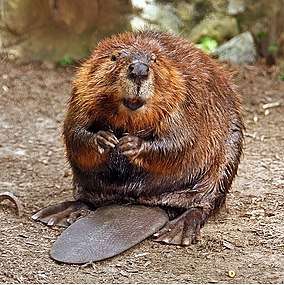
Construction
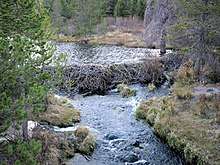
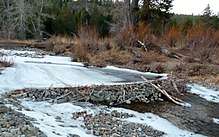
A minimum water level of 0.6 to 0.9 metres (2.0 to 3.0 ft) is required to keep the underwater entrance to beaver lodges from being blocked by ice during the winter. In lakes, rivers and large streams with deep enough water, beavers may not build dams and instead live in bank burrows and lodges.[1] If the water is not deep enough to keep beavers safe from predators and their lodge entrances ice-free, beavers build dams.
Beavers start construction by diverting the stream to lessen the water's flow pressure. Branches and logs are then driven into the mud of the stream bed to form a base[1]. Then sticks, bark (from deciduous trees), rocks, mud, grass, leaves, masses of plants, and anything else available, are used to build the superstructure. The average height of a dam is about 1.8 metres (5.9 ft) with an average depth of water behind the dam of 1.2 to 1.8 m. The thickness of the dam is often around 1 m or more. The length depends on the stream width, but averages about 4.5 m long.
Beavers vary the type of dam built and how they build it, according to the speed of water on the stream. In slow-moving water, they build a straight dam, whereas in fast-moving water they tend to be curved. Spillways and passageways are built into the dam to allow excess water to drain off without damaging it. Dams are generally built wider at the base and the top is usually tilted upstream to resist the force of the current. Beavers can transport their own weight in material; they drag logs along mudslides and float them through canals to get them in place.[2] Once the dam has flooded enough area to the proper depth to form a protective moat for the lodge (often covering many acres), beavers begin construction on the lodge.[3]
Trees approaching a diameter of 90 centimetres (3.0 ft) may be used to construct a dam, although the average is 10 to 30 cm. The length depends on the diameter of the tree and the size of the beaver. There are recorded cases of beavers felling logs of as much 45 m tall and 115 cm in diameter. Logs of this size are not intended to be used as structural members of the dam, but rather the bark is used for food, and sometimes to get at upper branches. It takes a beaver about 20 minutes to cut down a 15 cm wide aspen, by gnawing a groove around the trunk in an hourglass shape. A beaver's jaws are so powerful they can cut a 1.5 cm sapling in one bite.[3]
Maintenance work on the dam and lodges is particularly heavy in autumn.
Furthermore, if beavers are considered central place foragers, then their canals may be considered an extension of their "central place" far beyond the lodge, according to a 2004-2012 study that mapped beaver ponds and cut stumps.[4]
Extreme size
Beaver dams typically range in length from a few meters to about 100 metres (330 ft).[5] Additionally, canals can be over 0.5 kilometres (1,600 ft) in length.[6] The largest beaver dam known to exist is in Wood Buffalo National Park in Alberta, Canada and measures 2,790 feet (850 m) in length.[7] Satellite photos provided by NASA World Wind show the dam did not exist in 1975 but it appeared in subsequent images. It has two or more lodges and is a combination of two original dams. Google Earth images show new dams being built which could ultimately join the main dam and increase the overall length by another 50 to 100 m during the next decade.[8] Coordinates: 58°16'15"N 112°15'6"W
Another large beaver dam measuring 2,139 feet (650 m) long,[7] 14 feet (4.3 m) high and 23 feet (7.0 m) thick at the base was found in Three Forks, Montana.[3]
As tool use
It is claimed by some that by building dams, beavers are expressing tool use behaviour.[9] However, the definition of tool use by animals is highly contentious. For example, it has been argued that like bird nests, beaver dams are too large to be picked up by the animal and therefore cannot be classified as a tool. However, the cutting down of trees, preparing them for use, transporting them to the dam and then inserting them into the structure is consistent with other definitions of tool use.
Benefits
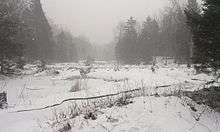
Dam building can be very beneficial in restoring wetlands. Such wetland benefits include flood control downstream, biodiversity (by providing habitat for many rare as well as common species), and water cleansing, both by the breakdown of toxins such as pesticides and the retention of silt by beaver dams. Over the years, this collection of silt produces the rich bottomland so sought after by farmers. Beaver dams reduce erosion as well as decrease the turbidity that is a limiting factor for much aquatic life. While beavers can create damage, part of the problem is one of perception and time scale. Such damage as the undermining of a roadway or the drowning of some trees is very visible shortly after the beginning of beavers' activity in an area. The benefits may be long-term and unnoticed except, for example, by someone monitoring a catchment. Almost half of endangered and threatened species in North America rely upon wetlands.[10]
In 2012, a systematic review was conducted on the impacts of beaver dams on fishes and fish habitat (biased to North America (88%)). The most frequently cited benefits of beaver dams were increased habitat heterogeneity, rearing and overwintering habitat and flow refuge, and invertebrate production. Impeded fish movement because of dams, siltation of spawning habitat and low oxygen levels in ponds were the most often cited negative impacts. Benefits (184) were cited more frequently than costs (119).[11]
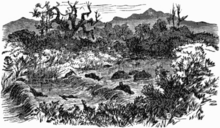
Flood control
A beaver dam has a certain amount of freeboard above the water level. When heavy rains occur, the river or lake fills up and the dam gradually releases the extra stored water. Often this is all that is necessary to reduce the height of the flood wave moving down the river, and will reduce or eliminate damage to human structures. Flood control is achieved in other ways as well. The surface of any stream intersects the surrounding water table. By raising the stream level, the gradient of the surface of the water table above the beaver dam is reduced, and water near the beaver dam flows more slowly into the stream. This further helps in reducing flood waves, and increases water flow when there is no rain. Beaver dams also smooth out water flow by increasing the area wetted by the stream. This allows more water to seep into the ground where its flow is slowed. This water eventually finds its way back to the stream. Rivers with beaver dams in their head waters have lower high water and higher low water levels.
Beaver dams also have a tendency to raise the water table, both in mineral soil environments and in wetlands such as peatlands. In peatlands particularly, they can stabilize the often fluctuating water table, which controls the levels of both carbon and water. In a 2017 study of beaver dam hydrology, monitored beaver dams in a Rocky Mountain peatland were found to increase groundwater storage and regional water balance, which can be beneficial for preventing drought. The study also suggested potential to improve carbon sequestration.[12]
Excess nutrient removal
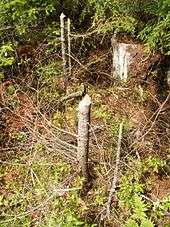
Beaver ponds can cause the removal of nutrients from the stream flow. Farming along the banks of rivers often increases the loads of phosphates, nitrates and other nutrients, which can cause eutrophication and may contaminate drinking water. Besides silt, the beaver dam collects twigs and branches from the beavers' activity and leaves, notably in the fall. The main component of this material is cellulose, a polymer of β-glucose monomers (This creates a more crystalline structure than is found in starch, which is composed of α-glucose monomers. Cellulose is a type of polysaccharide.) Many bacteria produce cellulase which can split off the glucose and use it for energy. Just as algae get their energy from sunlight, these bacteria get their energy from cellulose, and they form the base of a very similar food chain. However, a source of energy is not enough for growth. These bacterial populations face serious shortages of nitrogen and phosphorus compounds, and will absorb these nutrients as they pass by in the water stream. In this way, these and other nutrients are fixed into the beaver pond and the surrounding ecology, and are removed from the stream.
Pesticide and herbicide removal
Agriculture also introduces herbicides and pesticides into streams. Some of these toxicants are metabolized and decomposed by the bacteria in the cellulose-rich bottom of a beaver dam.
Denitrification
Some scientists believe that the nitrogen cascade, the production of far more fixed nitrogen than the natural cycles can turn back into nitrogen gas, may be as much of a problem to our ecology as carbon dioxide production . Studies have shown, that beaver dams along a stream contribute to denitrification (the conversion of nitrogen compounds back into nitrogen). Bacteria in the dirt and the plant debris, which collects at the dams, turns nitrates into nitrogen gas. The gas bubbles up to the surface and mixes with the atmosphere once more.[13]
Salmon and trout
Beaver dams and the associated ponds can provide nurseries for salmon and trout.[14] An early indication of this was seen following the 1818 agreement between the British government of Canada and the government of America allowing Americans access to the Columbia watershed. The Hudson's Bay Company, in a fit of pique, instructed its trappers to extirpate the fur-bearing animals in the area. The beaver was the first to be made locally extinct. Salmon runs fell precipitously in the following years, even though none of the factors associated with the decline of salmon runs were extant at that time.[15]
There are several reasons why beaver dams increase salmon runs. They produce ponds that are deep enough for juvenile salmon to hide from predatory wading birds. They trap nutrients in their ecology and notably the huge nutrient pulse represented by the migration of the adult salmon upstream. These nutrients help feed the juveniles after the yolk sac has been digested. The dams provide calm water which means that the young salmon can use energy for growth rather than for fighting currents; larger smolts with a food reserve have a better rate of survival when they reach the sea. Finally, beaver dams keep the water clear which favours all salmonoids.
Frogs
Beaver dams have been shown to be beneficial to frog and toad populations, likely because they provide protected areas for larvae to mature in warm, well-oxygenated water. This is important because this type of water enhances the development and growth of frog and toad larvae.[16] A study in Alberta, Canada, showed that "Pitfall traps on beaver ponds captured 5.7 times more newly metamorphosed wood frogs, 29 times more western toads and 24 times more boreal chorus frogs than on nearby free-flowing streams."[17]
Birds
Beaver dams help migrating songbirds. By stimulating the growth of species of plants that are critical to populations of songbirds in decline, beaver dams help create food and habitat for populations of songbirds in decline. The presence of beaver dams has been shown to be associated with an increased diversity of songbirds.[18] They can also have positive effects on local waterfowl, such as ducks, that are in need of high‐quality habitats.[19]
Stream life cycle
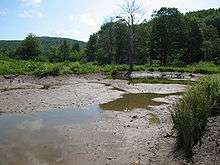
Wetland creation
If a beaver pond becomes too shallow due to sediment accumulation, or if the tree supply is depleted, beavers will abandon the site. Eventually the dam will be breached and the water will drain out. The rich thick layer of silt, branches, and dead leaves behind the old dam is the ideal habitat for wetland species. Many may have been on the fringes of the pond. Wetlands have significant environmental benefits.
Meadow creation
As the wetland fills up with plant debris and dries out, pasture species colonize it and the wetland becomes a meadow suitable for grazing in an area with nothing but forest down to the stream edge. This provides a valuable niche for many animals which otherwise would be excluded.
Riverine forest
Finally the meadow will be colonized by riverine trees, typically aspens, willows and such species which are favoured by the beaver. Beavers are then likely to recolonize the area, and the cycle begins again.
Bottomland
Each time the stream life cycle repeats itself another layer of rich organic soil is added to the bottom of the valley. The valley slowly fills and the flat area at the bottom gets wider. Research is sparse, but it seems likely that much of the fabled bottomland in North America was created, or at least added to, by the efforts of the generations of beavers that lived there.
Disruption
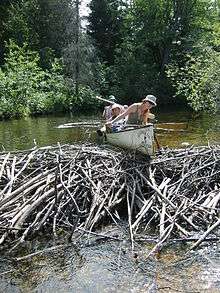
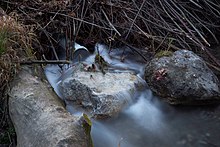
Beaver dams can be disruptive; the flooding can cause extensive property damage, and when the flooding occurs next to a railroad roadbed, it can cause derailments by washing out the tracks, or when a beaver dam bursts and the resulting flash flood overwhelms a culvert. Traditional solutions to beaver problems have been focused on the trapping and removal of all the beavers in the area. While this is sometimes necessary, it is typically a short-lived solution, as beaver populations have made a remarkable comeback in the United States (after near extirpation in the nineteenth century) and are likely to continually recolonize suitable habitat.[20] Modern solutions include relatively cost-effective and low maintenance flow devices. As for the dams, their construction is often too solid for them to be broken up manually or torn apart by machinery. One effective method for removing beaver dams is through the usage of dynamite. Introduced to an area without its natural predators, as in Tierra del Fuego, beavers have flooded thousands of acres of land and are considered a plague. One notable difference in Tierra del Fuego from most of North America is that the trees in Tierra del Fuego cannot be coppiced as can willows, poplars, aspens, and other North American trees. Thus the damage by the beavers seems more severe. The beaver's disruption is not limited to human geography; beavers can destroy nesting habitat for endangered species.
See also
- North American beaver
- Logjam, an accumulation of wood debris on a river or stream
References
- Baker, B.W.; Hill, E.P. (2003). Feldhammer; Thompson; Chapman (eds.). "Beaver (Castor canadensis)" (PDF). Wild Mammals of North America: Biology, Management, and Conservation (Second ed.). Baltimore, Maryland, USA: The Johns Hopkins University Press: 288–310 – via USDA APHIS.
- "Comparative Mammalian Brain Collections: North American beaver (Castor canadensis)". neurosciencelibrary.org. Retrieved 2020-03-08.
- Fall, S. (2007). "Beaver pictures & facts". Archived from the original on August 11, 2013. Retrieved September 2, 2013.
- Abbott, Matthew; Fultz, Brandon; Wilson, Jon; Nicholson, Jody; Black, Matt; Thomas, Adam; Kot, Amanda; Burrows, Mallory; Schaffer, Benton; Benson, David (2012-01-01). "Beaver-Dredged Canals and their Spacial Relationship to Beaver-Cut Stumps". Proceedings of the Indiana Academy of Science (Vol.121, No.2).
- "World's biggest beaver dam discovered in northern Canada". phys.org. Retrieved 2020-03-08.
- Grudzinski, Bartosz P.; Cummins, Hays; Vang, Teng Keng (2019-09-15). "Beaver canals and their environmental effects". Progress in Physical Geography: Earth and Environment: 0309133319873116. doi:10.1177/0309133319873116. ISSN 0309-1333.
- Strege, David. "Explorer first to reach world's largest beaver dam". Archived from the original on 24 September 2014. Retrieved 24 September 2014.
- Thie, J. "Exploring beaver habitat and distribution with Google Earth: The longest beaver dam in the World". Archived from the original on September 16, 2013. Retrieved September 2, 2013.
- "15 remarkable animals that use tools". Mother Nature Network. Archived from the original on September 11, 2013. Retrieved September 3, 2013.
- "About beavers". Beavers: Wetlands and Wildlife. Archived from the original on August 13, 2013. Retrieved September 3, 2013.
- Kemp, P.S., Worthington, T.A., Langford, E.L., Tree, A.R.J. and Gaywood, M.J., (2012). Qualitative and quantitative effects of reintroduced beavers on stream fish. Fish and Fisheries, 13(2): 158–181 DOI:10.1111/j.1467-2979.2011.00421.x
- Karran, Daniel J.; Westbrook, Cherie J.; Bedard‐Haughn, Angela (2018). "Beaver-mediated water table dynamics in a Rocky Mountain fen". Ecohydrology. 11 (2): e1923. doi:10.1002/eco.1923. ISSN 1936-0592.
- Lazar, Julia; Addy, Kelly; Gold, Arthur; Groffman, Peter; McKinney, Richard; Kellogg, Dorothy (16 September 2015). "Beaver Ponds: Resurgent Nitrogen Sinks for Rural Watersheds in the Northeastern United States". Journal of Environmental Quality. 44 (5): 1684–1693. doi:10.2134/jeq2014.12.0540. PMID 26436285.
- Grannes, S.G. (2008). "Beaver dam information site". Archived from the original on September 12, 2013. Retrieved August 30, 2013.
- "Beavers". nwcouncil.org. Archived from the original on 14 November 2012. Retrieved 2 May 2018.
- "wildlifeextra.com – wildlifeextra Resources and Information". www.wildlifeextra.com. Archived from the original on 20 December 2016. Retrieved 2 May 2018.
- "Beavers Helping Frogs And Toads Survive". Science Daily. January 11, 2007. Archived from the original on June 10, 2015.
- "Beavers: Dam Good For Songbirds". Science Daily. October 9, 2008. Archived from the original on May 30, 2017.
- Nummi, Petri; Suontakanen, Eeva-Maria; Holopainen, Sari; Väänänen, Veli-Matti (2019). "The effect of beaver facilitation on Common Teal: pairs and broods respond differently at the patch and landscape scales". Ibis. 161 (2): 301–309. doi:10.1111/ibi.12626. hdl:10138/302629. ISSN 1474-919X.
- Pollock, Michael M.; Morgan Heim; Danielle Werner (2003). "Hydrologic and geomorphic effects of beaver dams and their influence on fishes" (PDF). American Fisheries Society Symposium. 37: 213–233. Retrieved Feb 20, 2016.
External links
| Wikimedia Commons has media related to Beaver dams. |